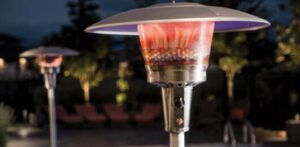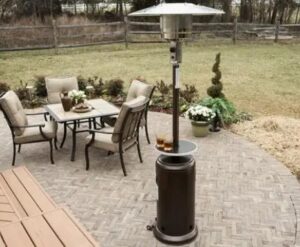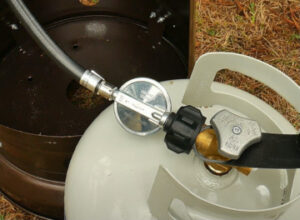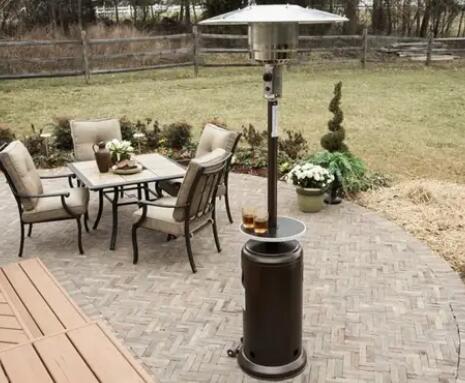Gas patio heaters can be useful additions to yards or outdoor gathering areas. They are also quite simple devices from a technological standpoint. You may, however, experience various challenges with your patio heater, like keeping it lit, but you will be surprised how some simple solutions for DIY homeowners to handle a solution on your own.
Common Problems Areas
- Pilot Light Issues
- Thermocouple Issues
- Air in The Gas Line
- Loose Connections/ Fittings
- Low Flame/ Heat
- Gas Level
- Gas Delivery
While several specific mechanisms allow them to function, the only elements that a gas heater needs to work are flame and fuel. Due to their straightforward design, on the rare occasion that one of these heaters does not work correctly, troubleshooting them is also straightforward. This post serves to keep you equipped with troubleshooting practices that will save you time and money in the long run. Here you will find the necessary things to check and change before writing your propane gas off as being broken.
What Are the Most Common Problems on Propane Patio Heater?
Propane patio heaters may encounter several problems; some familiar and minor issues have easy solutions. The troubleshooting techniques are listed below in order of most common to least common. Let’s check it out!

Pilot Light Issues
This issue is related to the thermocouple. If your heater has a pilot light, then the thermocouple may have failed, carboned up, or just got dirty or corroded. The thermocouple is usually cylindrical shaped and sits in the pilot light’s flame. The heat on the thermocouple reacts with its metal’s composition and keeps the gas supply open to the burner. (more on thermocouples here)
However, sometimes the pilot light can move away from the thermocouple. This action results in the thermocouple cooling (or not heating up at all) and shutting the flow of gas off. The thermocouple on the system detects no heat from the pilot light, and therefore it automatically shuts the heater down. This is a safety feature on most all gas appliances.
Carbon and dirt can build up on the orifice of the pilot light as well. This will diminish the way the flame stands or its power in essence and perhaps be the reason the flame is not on your thermocouple.
So, what to do if your pilot light flame is not on your thermocouple or your pilot flame has no power?
NOTE:
You may be aware , or unaware of this tid-bit of info?
When lighting a pilot light you have to hold the pilot light button down or leave it on the pilot setting until the thermocouple gets warm enough to allow gas flow.
Solutions to Adjust Pilot Light Issues
The solution here is quite simple, make a thermocouple adjustment. Turn the patio heater off, and using a pair of pliers (I prefer Needle Nose Pliers like these guys on Amazon), gently squeeze the thermocouple and manipulate it closer to the pilot light. To access the thermocouple and pilot light area, you need to remove the front control panel covering, the control knob, pilot light, and the heater’s top reflector most likely.
Remove the bracket that holds the thermocouple and pilot light together for better access if needed. Making sure you do not crush them. A gentle squeeze should do and a mild amount of force should do. Thermocouples are readily available patio heater parts and usually available from stock.
The solutions may be as simple as the thermocouple slipped down from its holding bracket out of the flame area too. Here just take a screw drive or nut driver and loosen, reposition and snug the screw (check it that it is snug enough that the heat wont make it loose and slip again).
The orifices may acquired a build-up of carbon or dirt and in turn diminish the flow of gas and, ultimately, the flame power. If this is the case, a pipe cleaner, maybe a toothpick, or a small wire brush could clear the obstructions fairly simply.

Thermocouple Issues
The thermocouple is easily affected by these factors. For example, corrosion wreaks havoc which goes along with age of the thermocouple. Often the thermocouple just quits working though.
The thermocouple properties are such that heat generates a small electrical voltage that triggers a tiny fail safe solenoid in the gas valve. One could consider the thermocouple like a lightbulb, it either works or it doesn’t. As it ages it could actually produce voltage, but just not enough to engage the fail-safe solenoid.
On a propane heater, the thermocouple will turn off the patio heaters gas supply, this is a safety on all gas appliances. So, another simple cause may be a breeze blowing out the pilot light and therefore kicking in the fail safe shut down.
However, mostly the culprit is a carbon layer or carbon chucks absorbing the heat instead of the thermocouple itself. Or, the thermocouple has some age and simply has failed.
A good indication that the thermocouple is malfunctioning is that the pilot light goes out when you try to turn the heater on. Make sure you check out the note above!
Solutions for Thermocouple Problems
The solution for carbon and corrosion on a thermocouple can be easily fixed. Light sandpaper or steel-wool can be used to sand off the outer debris and carbon.
Thermocouples are readily available patio heater part and usually available locally at a hardware store. If you are like me and have plenty of jobs to do around the house and want to order it and have it come to you to finish the job next week, check out these patio heater thermocouples on Amazon.
Air in the Gas Line
Air can become trapped in the gas line which can block the propane from flowing to the heater head combustion area. This usually only happens after a tank change, or a low tank.
Solutions for Air in the Line
In this case, you can purge the gas line. You are required to turn the knob on the propane tank to open the gas line fully.
Depress the control knob for another two to three minutes to ensure all the gas has cleared out. You can now attempt to ignite the patio heater again. If the propane gas tank is new, you will also need to purge the air from the gas lines, as explained.
If you smell gas and it still doesn’t light or stay lit, move on to another possible problem area.
Loose Connections and Fittings
Loose fittings and connections may be the cause of problems with your propane heater. Typically a loose connection can be detected by smell, however being an outdoor heater the breeze may be taking the odor away? There is a simple fast easy check for this possible problem in the solution below!

Solution for Loose Connections
You should examine the regulator and ensure it is connected tightly to the propane tank. Check the fittings as well.
The advisable and most recommended way is to use soapy water mix and dowse the connection area – the presence of bubbles indicates there is a leak.
I like using a spray bottle, you can reuse any spray bottle, but it is nice to have a go-to soapy water bottle for all your household needs. Like, slow leaks in your tires, and other appliances. Here are some spray bottles for your special solutions available on Amazon, Spray Bottles
Low Flame/ Low Heat
The heater may stay lite, but not give off enough heat and not adjust above a low flame, this would most likely be caused by low gas pressure. If the outdoor temperature is lower than 40 degrees Fahrenheit (4.5C), and the tank is less than one-quarter full, it will result in a lower pressure and flame. There could also be a issue with the heaters regulator. The gas may be on, but there is low gas flow.
Solutions for Low Heat
Check the tank, if it is low or near empty. If so, you need to replace, or have the tank refilled.
You may need to replace the hose and regulator assembly if your tank all is well everywhere else. Here are a few manufactures brands of Hose & Regulator on Amazon to check prices and availability.
A kinked gas hose could also cause a low flame. You should check the gas line/ hose and see if there is a kink. If there is a kink, try and straighten it out. But be causious not to damage the line…Nobody wants a leaking gas line. If damaged, you will have to replace it.
Blockage in the burner assembly is a potential cause as well. this will reduce the air mixture or ability to exhaust. Clean the emitter screen and burner to clear any blockages. Also, check the reflector and ensure there is no build-up of carbon.
Gas Level in Tank
Here is a line from a manufacture… The propane heater may not work as a result of no gas.
OK, that always cracks me up, but it is a problem that can arise. Just go to the base of the heater and check the weight of the gas tank. Check the solutions area for more details
Solutions on Tank Level
A full tank usually is heavier than an empty one (this comment goes along with the, may not work without gas), so if the tank is lightweight, you will need to refill it or replace it with a full one.
A empty propane tank weighs around 17lb (7.7kg). and a full tank weighs about 37lb (16.7kg). and each gallon of liquid propane or LP is 4.2lb per gallon (1.9kg)
There may be a small amount of LP left in the removed tank, but a replacement is more than likely needed anyway, because a minimal amount of gas is required to create enough pressure to force the gas to the burner. This is especially true when trying to start the heater up with a small amount in the tank even though it may have been running fine when last shut down. It is just easier to keep something running than starting it up on low pressure.

Gas Delivery to the Burner
With a full cylinder in place, turn on the gas and listen near the burner. Do you hear the gas? Or do you smell the gas? Once you smell the gas, let it set for a while before trying to light it.
If the patio heater has an electronic piezo ignition system, there should be a spark. can you hear the spark? If the heater does not light, try using a lighter to light the burner. If it still does not light, there may be a problem with the gas regulator.
Solutions for Gas delivery
The gas regulator is the little silver thing usually very close to the tank. This device reduces the pressure to 10, 20 or 30PSI dependent on the manufacture. They are usually are low pressure preset units for heaters, however they make adjustable ones. There are also high pressure regulators which are usually for higher BTU’s.

Most heaters that are portable would have a low pressure regulator, if you can’t get the actual manufacturers replacement an adjustable regulator would do the trick. Check out these adjustable low pressure regulators on Amazon.
If you get an adjustable regulator replacement, you would want to start at about a 1/4 of the way open, and adjust from there.
Much depends on the manufacture, typically the rise in height the regulator will ad the pressure needed. Just make sure you have a 3/8″ (10mm) hose size when purchasing you replacement for the average portable heat situation.
Some regulators have a flip switch that prevents the valve in the top of the cylinder from being depressed, effectively acting as an OFF switch. If your patio heater has such a button, ensure it is turned to the on position.
Piezo Igniter Problems
Other problems may arise from an old piezo igniter. They may get worn out and fail. Here you can use a stick lighter to ignite the heater. I will share with you my favorite lighter that I love, it will light anything because it is long enough and flexible enough to fit anywhere. It doesn’t need refilled either, it is a lifetime purchase. My favorite heater lighter, I got mine from Amazon
If it does start, you need to replace the worn-out igniter with a new one
Other Solutions to Try
Clearing of the Gas Lines
A gas line is rarely blocked, but it is still a possibility. You must remove connectors of the tube from the regulator and the gas inlet at the top of the heater. This line is pressure fitted and held in place by pipe clips or compression fittings. You can clear the gas pipe by blowing air through it. You may either blow air to free the blockages or make a pipe cleaner with a small solid copper wire.
Cleaning the Burner
Disassemble the burner and check for any blockages. The burner apertures (opening holes) should be set correctly as well. Beneath every burner, there is a small chamber where air and gas are mixed. Ensure the air and gas inlets are clear. If any blockages are discovered, clean the burner.
The air mix area is where those pesky bugs or spiders like to build there nest and block the flow, again the copper wire, or an old wire coat hanger may work here to clear the blockage.
Bug screen Dirty
Most of the propane patio heaters have a bug screen that work to keep insects that are attracted to the flame away. If the insect guard becomes too obstructed, it can result in blocking the flow of exhaust air and ultimately smother your flame. You should shut down and allow to cool, then remove the screen and clean it by either blowing on it or with a quick wash and thorough drying.
Freezing of the Regulator
A problem that may inflict a regulator from freezing up is liquid propane entering and passing through the control device. In this case, you will have to ensure that tank is positioned and located as designed for manufactures use. making sure the regulator is a little higher that the top of the tank should keep liquid propane from any downstream mechanics. Heaters are designed to work with propane vapor.
Sometimes the regulator does not fit onto the gas cylinder. A small leak could cause freezing around the regulator as well. If the threads are crossed, or it is the wrong cylinder, with gloves, shut the tank off, and check thread alignment.
Do you Still Have Questions?
Whether you need some extra heat on those colder evenings or you just want to have a heater for a style statement, patio heaters are a useful addition to your outdoor spaces and areas. Irrespective of the type brand or style heater you own, be it an electrical heater, propane heater, or a natural gas heater, each has its troubleshooting methods. So always refer to the manual for specific safety information.
Conclusion
The above solutions were generalistic for most propane and natural gas heaters and fall under possible repair methods for all manufactures.
If you have carried out all the checks and the heater will still not light, you can repeat all the checks and procedures slowly and carefully again, or take your heater to a service specialist. Any other modifications that do not involve ignition issues on your heater will vary according to the manufacturer. You can call the manufacture, however many local appliance repair persons can check your heater out too.
Most occasions when your patio heater requires troubleshooting techniques the methods listed above will help.
Will Montgomery draws on real-world use and mechanical know-how to explain how to fix patio heaters without calling a pro.


